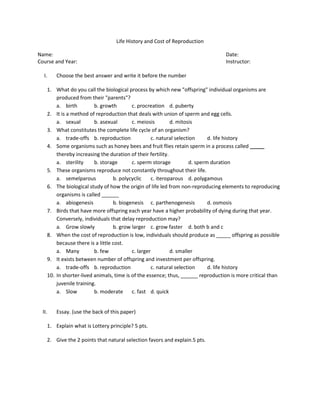Life history & cost quiz
- 1. Life History and Cost of Reproduction Name: Date: Course and Year: Instructor: I. Choose the best answer and write it before the number 1. What do you call the biological process by which new "offspring" individual organisms are produced from their "parents"? a. birth b. growth c. procreation d. puberty 2. It is a method of reproduction that deals with union of sperm and egg cells. a. sexual b. asexual c. meiosis d. mitosis 3. What constitutes the complete life cycle of an organism? a. trade-offs b. reproduction c. natural selection d. life history 4. Some organisms such as honey bees and fruit flies retain sperm in a process called _____ thereby increasing the duration of their fertility. a. sterility b. storage c. sperm storage d. sperm duration 5. These organisms reproduce not constantly throughout their life. a. semelparous b. polycyclic c. iteroparous d. polygamous 6. The biological study of how the origin of life led from non-reproducing elements to reproducing organisms is called ______ a. abiogenesis b. biogenesis c. parthenogenesis d. osmosis 7. Birds that have more offspring each year have a higher probability of dying during that year. Conversely, individuals that delay reproduction may? a. Grow slowly b. grow larger c. grow faster d. both b and c 8. When the cost of reproduction is low, individuals should produce as _____ offspring as possible because there is a little cost. a. Many b. few c. larger d. smaller 9. It exists between number of offspring and investment per offspring. a. trade-offs b. reproduction c. natural selection d. life history 10. In shorter-lived animals, time is of the essence; thus, ______ reproduction is more critical than juvenile training. a. Slow b. moderate c. fast d. quick II. Essay. (use the back of this paper) 1. Explain what is Lottery principle? 5 pts. 2. Give the 2 points that natural selection favors and explain.5 pts.


